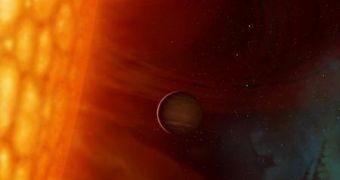It's a known fact that the Sun will reach a point where it burns its hydrogen and will start swelling as it gets warmer, transforming into a red giant, and that all this will occur in approximately 5 billion years. But first, in about 1.1 billion years, it will become 11% brighter, lifting the Earth's average temperature to about 50°C (120°F), which will cause the oceans to evaporate. The vapors will dissipate all their hydrogen molecules into space, under the influence of the Sun's UV light, and all life depending on water and hydrogen will be obliterated as such. 2 billion years later, the Sun will have swallowed our planet. Assuming we manage to resist as race by then, what should we do?
Let's strain ourselves into believing that, 5 billion years from now, we've managed to overcome all the problems related to overpopulation, lack of food, pollution, global wars and all the other spooky scenarios that threaten us today. What can we do to shield ourselves from the wrath of the Sun? Since it would take about 2,700 years at a rate of 1,000 launches daily to move all the population (of today) to another terraformed planet, scientists propose we move the Earth instead. And, since we have no direct means to push it, we'll have to force other celestial bodies into helping us.
The reason we shouldn't leave this on the shoulders of our descendants is that the process must be started as soon as possible, in order to get a good result in time. Being on Mars' orbit in 6.3 billion years would provide us about the same light we receive today from the Sun. However, in order to shift Earth to an orbit where Mars currently is, we would have to use the gravity tug of asteroids brought in from the Kuiper Belt. This means changing their orbit and bringing them closer to our planet, so that they could lend some of their orbital energy to us.
Pushing them until their orbit is fine-tuned according to our needs, and then letting them do their job would be easier than trying to push the Earth directly. But the problems this approach raises are bigger than their benefits. Supposing we will be able to do this, the KBOs would have to pass at about 10,000 km close to the Earth for them to be efficient, which could prove disastrous at the slightest miscalculation or unexpected phenomenon occurrence. Even more, moving planets and large asteroids has enormous disturbing impacts on the orbits of the rest of the planets, which are in a faint, fine balance with each other, ours included.
Another suggestion came in the form of a giant thin solar sail, 19.2 times larger than the diameter of our planet tilted at a 35° angle in report to a straight line from Earth to the Sun. This would use the faint pressure of Sun's light to reflect back on Earth and gently push it towards its new designated place. Unfortunately, we currently lack the necessary technology to perform either of the two approaches. Perhaps the future will bring new discoveries that will make protecting from the Sun more of a piece of cake.

 14 DAY TRIAL //
14 DAY TRIAL //